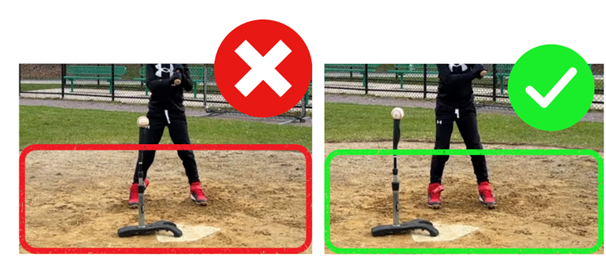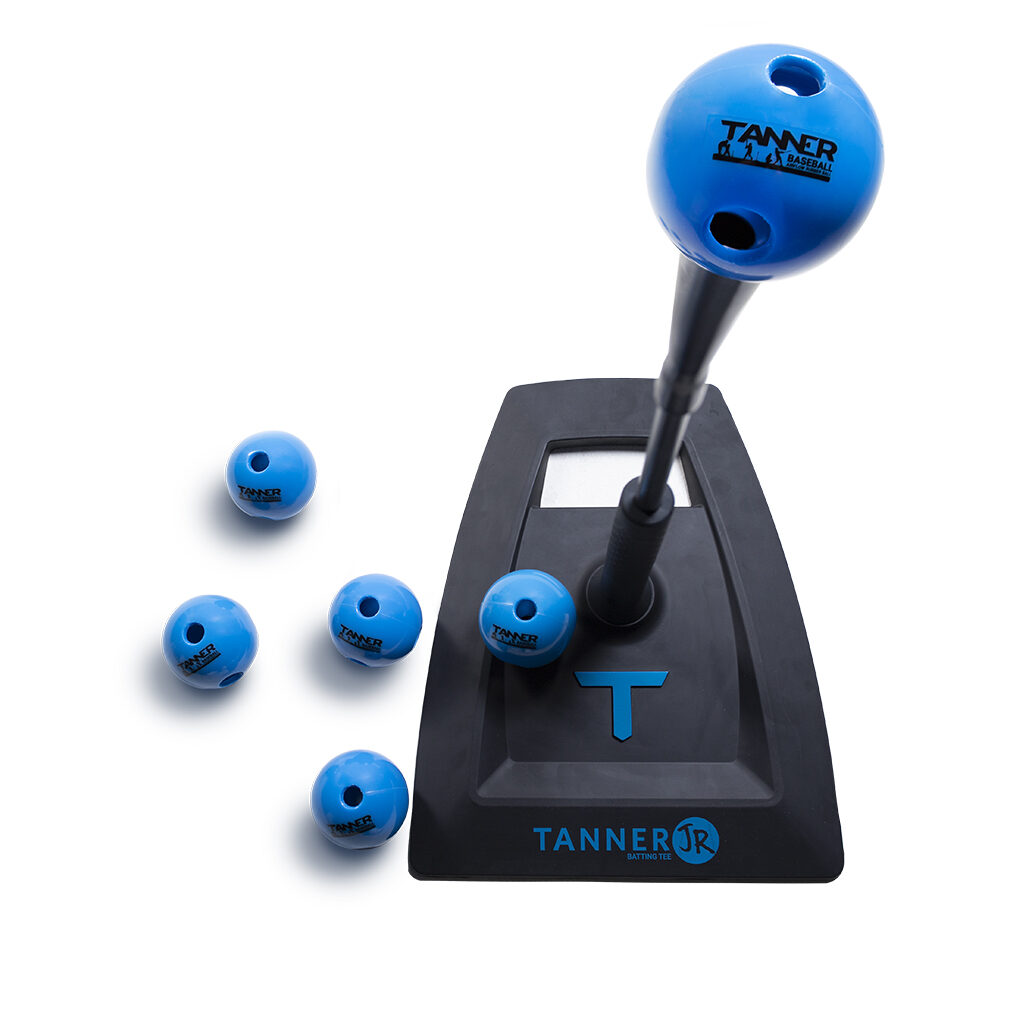Search Articles
Avoid this Batting Tee Mistake

Est. Reading:
8 min
Updated: September 20, 2023
Article Contents
Where should you stand when hitting off a batting tee?
This question is a VERY important one… and unfortunately, it’s one of the most common batting tee mistakes that less experienced players make when using a batting tee.

The Common Batting Tee Mistake
The batting tee is an essential piece of batting practice equipment. One of the MOST COMMON mistakes that young baseball and softball players make when learning to use a batting tee is that they are too far forward.
If you take your stride and your foot lands in front of the batting tee, then the baseball or softball is too deep for the hitter to make ideal contact with it. In other words, this positioning relative to the tee makes it impossible to hit the ball with the correct form.
At best, this stance is not helping you get better.
At worst, the hitter can develop bad habits and reinforce bad form if this isn't caught and corrected.
A Helpful Rule of Thumb for Getting the Most From Batting Tee Work
Former Major Leaguer Matt Antonelli posted a video in which he shares the tee routine he uses with his son (see below for the full video). In his video, he shares a simple “rule of thumb” to easily fix the hitter’s positioning relative to the batting tee.
So, what's the answer to, "Where should you stand when hitting off a batting tee?"
Here is Matt's “rule of thumb” that can help any baseball or softball player correct this mistake quickly and get it right every time.
— Rule of Thumb—
At contact, your stride foot should end up even with the batting tee.
Notice the rule of thumb says “at contact” That means you’ve already taken your stride and your bat is making contact with the baseball.
At that point, notice where the lead foot lands. You want it to be roughly even with the batting tee.
If it’s not, then you’ll want to move the starting point back, away from the pitcher. Do it a few inches at a time, until the final result (at contact) is that your foot lands about even with the batting tee.

To see it in action and to watch how former MLB player Matt Antonelli uses his Tanner Heavy as he coaches his son through a hitting routine, click play on the video below.
Video Transcript
Okay, so now we're gonna go through a hitting routine. We're gonna start off with the tee. The tee is a great tool to use for a couple of different reasons. One, if we're working on any specific mechanical things, there's no timing involved, so the hitter can really focus on what their body is doing. We're not going to use that for that particular reason right now. Right now, we're basically just getting ourselves loose.
Thank you for hitting me in the shin right there; that felt good. Okay, so a couple of mistakes I see with the tee. The first thing is if you're gonna hit a ball down the middle, the general rule is at the stride foot. So, let me see this real quick, buddy, your stride foot should land in line with the tee. So if I'm a lefty, it's there. If I'm a righty, heads up, real quick, are you right there? My stride foot should be in line with the tee. That allows me to hit the ball out front.
One problem I see a lot with tee work is that the hitters are past the ball, right? I've got to be able to make contact with the ball out in front, and out in front, again, on a ball down the middle, I'd say basically in line or slightly in front of your front foot when you stride. So if you have a hitter that starts here and they're gonna stride, they're gonna go past the ball. I've watched a lot of t-ball, watching him when he was in t-ball a couple of years ago, and it's - and now my daughter is - it's a huge mistake I see players come up; they have no idea. We understand most of them stand far too far forward. Okay, it's gonna be way too far back exactly. Everything's gonna be hit to the opposite field if you're lucky or it's gonna be hit into the dugout. Okay, it's going to be foul, exactly. So let's start off there. We'll - we're going to start middle just to give the hitter an understanding of kind of where they need to be to be able to hit the ball. So I'll get out of the way; we'll take a couple of swings.
So you're gonna start, yep, just behind the ball. Good job, good swing. So hold on one sec. So here's an example. If I'm watching him, I'm going to stand over here near the camera because this is the angle, and I'm going to be able to watch. Okay, go ahead, buddy.
(Video continues with hitting off the tee demonstration and instructions for hitting inside and outside pitches)
So those are all basically right-center field. Now what we'll do is we're going to move the tee back and we're going to go outside pitch. So let's move this over here again. So if you think about if we take three balls real quick, if we move this, we put the ball down the middle right there, we put the ball inside about right there, and we're going to put the ball outside about right there. So it's not a huge dist - it's not, it's not this, it's just a little bit. We're talking a couple of inches each way. So after I move this outside ball, we're going to put the tee right there.
We do hit the outside pitch a little bit deeper, but we're not trying to get the ball way back there. Okay, so we're gonna put it right here on the edge of the plate, and I'm gonna try to hit it. You're gonna stay in the same spot, though, the same spot that you've been. Now we talked about how your foot's gonna be even on the ball down the middle. Now we're probably going to be just ever so slightly in front of that even line to be able to drive the ball down the camera. Imagine if I hit a foul ball when it hits the camera; you're not going to hit the camera. All right, so here we go. So remember your front foot now needs to land just slightly past the ball, so you've got to slide up a little bit. If you're too far behind - right there, there we go. Very good, good. No, that's - I mean, that right there, I know you guys couldn't see that, that was basically between the shortstop and the second baseman. Try that again. You're gonna be up a little bit, gonna catch this ball a little bit deeper. Yeah, left-center field. Very good, so it's a line drive basically over the shortstop's head. Try that again, god, everything I hit is in the middle. You're good, try to hit the ball hard to left-center field right now.
A couple more tips when it comes to hitting off the tee. You can notice with him, and this isn't just with him but it's with most players, most players are better at pulling the ball, especially at a young age and then going to the opposite field. So you can see most of his balls he actually hits the majority of his balls to the middle of the field, which is kind of what we talk about a lot, saying left-center or right-center. But you'll notice they'll probably struggle a little bit more on the outside part of the plate, but the tee is great again to learn the point of contact, understand that the ball inside is going to be hit a little bit more out front, the ball is going to get hit a little bit deeper the further away from us it goes, so they're going to learn point of contact, which is important. They're going to learn how to be able to hit the ball the other way, how to hit it middle, how to be able to pull the ball.
The other thing to think about is moving the height of the pitch. So you can move it up, you can move it down. So, well, let's hold on one sec. So the biggest issue, one of the biggest issues I see after not knowing where to stand is always having the tee at the exact same spot every single time. So move the tee around, make it middle, inside, and outside, make it be up and down, try to cover all quadrants of the hitting zone.
All right, now he's going to move on, apparently, to base running; he just slid into first base. So, so hopefully that helps you out. Let me know if you have any questions in the comment section below, subscribe to the channel, hit the notification, give a thumbs up, all that good stuff. We'll talk to you later. If you've got hitters that you're looking to improve before the start of next season, this is essential for you. Matt Antonelli here, former major league player
Equipment used in Video
- Tanner Heavy Tee - The Heavy Tee is a professional quality batting tee. It features our highest level of stability thanks to the 10lb claw base. It remains stable on any surface, including a raised home plate or grass.
- Practice Baseballs - One dozen practice baseballs have a cork center, are dual rubber protected, are 20% wool, and have a premium leather cover.
Related Equipment
Tanner Jr. Batting Tee
If you’re just getting started with a very young hitter (ages 3 to 8) the Tanner Jr. is the best t-ball tee or kid's batting tee on the market (in our opinion.)

The Tanner Jr features a rugged metal stem over-molded with soft rubber and a sturdy flexible rubber base that provides stability. Parents love that can rest on top of home plate for t ball gameplay or on grass for backyard play.
The ball rest is a flexible rubber cone that encourages hitters to swing hard through contact.
The Hitting Deck
The Hitting Deck shows hitters the proper foot and batting tee placement to maximize tee work practice to build more power and skill at bat.
It can be helpful for young hitters to self-correct when working alone and as a visual aid for coaches and parents working with young athletes.


